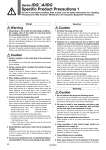
es30-7f-idgü@ü@ü@51 / 54
10ĢbīŃé╔BOOKé╠āyü[āWé╔ł┌ō«éĄé▄éĘ
Selection Caution 1. Consider the purge air flow rate. Find the purge air flow rate from the charts and calculate the ügrequired outlet air flow rate + purge air flow rateüh. The air supply capacity must be at least equal to the calculated flow or the required outlet air flow rate cannot be obtained. 2. Selection for a compressed air line in which a mist separator or micro mist separator is already installed Verify the operating air flow rate and air pressure, and select a membrane air dryer in accordance with ügModel Selectionüh (page 31). If a membrane air dryer is selected using the port size of the equipment that is already installed as a reference, it could result in the selection of a model that is too small and has an insufficient dehumidification capacity. 3. With fitting for purge air discharge (Semi-standard: P) The dehumidification capacity decreases in proportion to the length of the tube for discharging purge air. Use a tube of the specified size and keep its length within 5 meters. For the outlet air atmospheric pressure dew point in relation to the length of the tube for discharging purge air, refer to the table ügregarding the outlet air atmospheric dew point in relation to the tube length for purge air dischargeüh on page 8. 4. Auto-drain selection for the unit type When the compressor in use is for 2.2 kW (300 L/min [ANR]) or less, use an N.C. auto-drain (symbol: C). If an N.O. auto-drain (symbol: D) is used when the compressor is for 2.2 kW or less, pressure inside the mist separator may not increase and remain in the state of blowing off. Auto-drain with differential pressure type can be used in 2.2 kW or less. Mounting Caution 1. Do not obstruct the purge air discharge ports. The product may be damaged. And if purge air back pressure becomes too high or purge air stops flowing, dehumidification performance will decrease or may become impossible. 2. Be sure to install a mist separator and micro mist separator or a micro mist separator with pre-filter on the inlet side of the membrane air dryer. If the inlet air contains oil, performance will be reduced. (A mist separator and micro mist separator or a micro mist separator with pre-filter are already installed on the unit types.) 3. Remove water droplets from the inlet air. Water droplets in the air can lower performance and cause malfunction. 4. Large quantities of dust (solid foreign matter) are contained in the supply air. When there are large quantities of dust (solid foreign matter), install an air filter or main line filter to the inlet side of the mist separator in addition to 2 above. 5. Take sufficient care in handling. There is a danger of damage if dropped. 6. When using a fixture, fix it on the metal part of the product. Using a fixture on the resin part may cause damage to the product. Caution 1. Install a regulator on the outlet side of the membrane air dryer. If it is installed on the inlet side, dehumidification performance will be reduced. 2. Devise a layout which considers the position of purge air discharge ports. Purge air is humid air. Devise a layout in which purge air will not cause trouble such as corrosion or malfunction of peripheral equipment. 3. When highly purified air is required (Supply to air bearings, blowing of semiconductor parts, etc.) Install a micro mist separator or super mist separator on the outlet side (end terminal) of the membrane air dryer (unit). Grease is applied inside a regulator used in the unit (Type V). When highly purified air is required, please either mount the above separator on the outlet side or use a made-to-order product (refer to pages 37 and 38), which is provided with a micro mist separator (Series AWD) instead of a regulator. 4. Time to reach the standard dew point A certain amount of time is required to achieve the standard dew point after the air begins flowing into the membrane air dryer. Using the times below as a guide, begin operating outlet side equipment after the standard dew point is achieved. Standard dew point .20üŗC, .15üŗC : about 10 minutes Standard dew point .40üŗC : about 30 minutes . Standard dew point .60üŗC : about 60 minutes . . This time can be shortened as described below. 1) Provide a valve on the outlet side of the membrane air dryer. 2) Supply air with the valve closed. Only purge air flows into the membrane air dryer. 3) After 15 minutes or more, open the valve and let air flow to the outlet side equipment. 5. Dehumidification performance when inlet air temperature changes Performance chart shows the case at an inlet air temperature of 25üŗC. In other cases, refer to ügModel Selectionüh (page 31) for proper selection. 6. Do not use for applications such as repeatedly bending or stretching (IDG1). This may cause damage to the product. Design Warning 1. Depending on the model and operating conditions, the oxygen ratio of the outlet air may drop below the prescribed standard. Do not use standard dew point .40üŗC (symbol: L) type, standard dew point .60üŗC (symbol: S) type and IDG30A, 50A, 30HA, 50HA for dehumidifying breathing air. Do not use only outlet air (dry air) in a closed room. 2. Do not exert intermittent pressure on this product. (Example: Frequently operating solenoid valves installed on the primary side) Intermittent pressure damages the product. Series IDG«A/IDG Specific Product Precautions 1 Be sure to read before handling. Refer to back cover for Safety Instructions and ügHandling Precautions for SMC Productsüh (M-E03-3) for Air Preparation Equipment Precautions. 45